英语四级完形填空及解析
四级英语完形填空练习题及答案解析

四级英语完形填空练习题及答案解析Who won the World Cup 1994 football game? What happened at the United Nations? How did the critics like the new play? 1 an event takes place; newspapers are on the streets 2 the details. Wherever anything happens in the world, reports are on the spot to 3 the news.Newspapers have one basic 4 , to get the news as quickly as possible from its source, from those who make it to those who want to 5 it. Radio, telegraph, television, and 6 inventions brought petition for newspapers. So did the development of magazines and other means of munication.7 , this petition merely spurred the newspapers on. They quickly made use of the newer and faster means of munication to improve the 8 and thus the efficiency oftheir own operations. Today more newspapers are 9 and read than ever before. Competition also led newspapers to branch out to many other fields. Besides keeping readers 10 of the latest news, today's newspapers 11 and influence readers about politics and other important and serious matters. Newspapers influence readers' economic choices 12 advertising. Most newspapers depend on advertising fortheir very 13 .Newspapers are sold at a price that 14 even a small fraction of the cost of production. The main 15 of ine for most newspapers is mercial advertising. The 16 in selling advertising depends on a newspaper's value toadvertisers. This 17 in terms of circulation. How many people read the newspaper? Circulation depends 18 on the work of the circulation department and on the services or entertainment 19 in a newspaper's pages. But for the most part, circulation depends on a newspaper's value to readers as a source of information 20 the munity, city, country, state, nation, and world—and even outer space.1.A.Just when B.While C.Soon after D.Before2.A.to give B.giving C.given D.being given3.A.gather B.spread C.carry D.bring4.A.reason B.cause C.problem D.purpose5.A.make B.publish C.know D.write6.A.another B.other C.one another D.the other7.A.However B.And C.Therefore D.So8.A.value B.ratio C.rate D.speed9.A.spread B.passed C.printed D.pletedrm B.be informed C.to be informed rmed11.A.entertain B.encourage Ccate D.edit12.A.on B.through C.with D.of13.A.forms B.existence C.contents D.purpose14.A.tries to cover B.manages to cover C.fails to coverD.sueeds in15.A.source B.origin C.course D.finance16.A.way B.means C.chance D.suess17.A.measures B.measured C.Is measured D.was measured18.A.somewhat B.little C.much D.something19.A.offering B.offered C.which offered D.to be offered20.A.by B.with C.at D.about第三篇答案+讲解:1.【答案】A【解析】just在此为副词,意为“刚刚”,做状语。
大学英语四级完形填空(附答案解析良心制作)

大学英语四级完形填空第一篇Most people have no idea of the hard work and worry that goes into the Collecting of those fascinating Birds and animals that they pay to see in the zoo. One of the questions that is always asked ofinterested in animals and zoos. According to my parents, the first word I was able to say with any (3) was not the C onventional “mamma” or “daddy”, (4)the word “zoo”, which I would (5) over and over again with a shrill (6) until someone, in groups to (7) me up, would take me to the zoo. When I (8) a little older, we lived in Greece and I had a great (9) of pets, ranging from owls to seahorses, and I spent allpets. (12) on I went for a year to the City Zoo, as a student (13) , to get experience of the large animals, such as lions, Bears, Bison and ostriches, (14) were not easy to keep at home. When I left, I (15) had enough money of my own to Be able to (16) my first trip and I have Been going (17) ever since then. Though a Collector's job is not an easy one and is full of (18), it is Certainly a job which will appeal (19) all those who love animals and (20) .1.A.how B. where C. when D. whether2.A.region B. field C. place D. Case3.A.clarity清晰 B. emotion C. sentiment(情绪) D. affection(情感)4.A.except B. But √ C. except for D. But for5.A.recite B. recognize C. read D. repeat6.A.volume B. noise C. voice √ D. pitch7.A.close B. shut √ C. stop D. Comfort8.A.grew √ B. was growing C. grow D. grown9.A.many B. amount C. number √ D. supply10.A.living B. Cultivating 耕种 C. reclaiming 开垦 D. exploring探察11.A.increase B. include C. add √ D. enrichter √ B. further C. then D. subsequently13.A.attendant 仆人 B. keeper C. member D. aide14.A.who B. they C. of which D. which√15.A.luckily B. gladly C. nearly D. successfully16.A.pay B. provide C. allow D. finance支付17.A.normally B. regularly C. usually D. often18.A.expectations B. sorrows C. excitement D. Disappointments√19.A.for B. with C. to√ D. from20.A.excursion B. travel √ C. journey D. Trip第一篇解析:1.【答案】A 根据下一句及随后的内容,作者讲的是怎样成为动物爱好者的(从小就喜欢动物),应当选择A.how。
大学英语四级完形填空30篇[附答案解析]_打印整理版
![大学英语四级完形填空30篇[附答案解析]_打印整理版](https://img.taocdn.com/s3/m/555d2523dc36a32d7375a417866fb84ae45cc3b4.png)
大学英语四级完形填空第一篇Most people have no idea of the hard work and worry that goes into the collecting of those fascinating birds and animals that they pay to see in the zoo. One of the questions that is always asked of me is <1> I became an animal collector in the first <2>. The answer is that I have always been interested in animals and zoos. According to my parents, the first word I was able to say with any <3> was not the conventional "mamma" or "daddy", <4> the word "zoo", which I would <5> over and over again with a shrill <6> until someone, in groups to <7> me up, would take me to the zoo. When I <8> a little older, we lived in Greece and I had a great <9> of pets, ranging from owls to seahorses, and I spent all my spare time <10> the countryside in search of fresh specimens to <11> to my collection of pets. <12> on I went for a year to the City Zoo, as a student <13> , to get experience of the large animals, such as lions, bears, bison and ostriches, <14> were not easy to keep at home. When I left, I <15> had enough money of my own to be able to <16> my first trip and I have been going <17> ever since then. Though a collector's job is not an easy one and is full of <18>, it is certainly a job which will appeal <19> all those who love animals and <20> .1.A.how B. where C. when D. whether2.A.region B. field C. place D. case3.A.clarity B. emotion C. sentiment D. affection4.A.except B. but C. except for D. but for5.A.recite B. recognize C. read D. repeat6.A.volume B. noise C. voice D. pitch7.A.close B. shut C. stop D. comfort8.A.grew B. was growing C. grow D. grown9.A.many B. amount C. number D. supply10.A.living B. cultivating C. reclaiming D. exploring11.A.increase B. include C. add D. enrichter B. further C. then D. subsequently13.A.attendant B. keeper C. member D. aide14.A.who B. they C. of which D. which15.A.luckily B. gladly C. nearly D. successfully16.A.pay B. provide C. allow D. finance17.A.normally B. regularly C. usually D. often18.A.expectations B. sorrows C. excitement D. disappointments19.A.for B. with C. to D. from20.A.excursion B. travel C. journey D. Trip第一篇解析:1.[答案]A根据下一句及随后的内容,作者讲的是怎样成为动物爱好者的<从小就喜欢动物>,应当选择A.how。
英语四级完形填空试题及答案解释
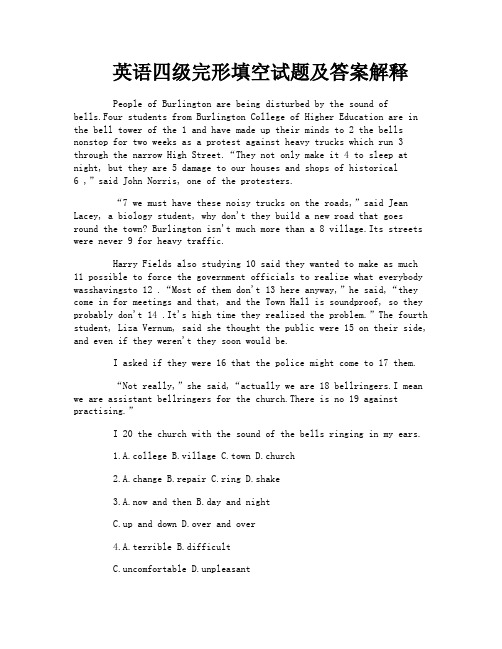
英语四级完形填空试题及答案解释People of Burlington are being disturbed by the sound ofbells.Four students from Burlington College of Higher Education are in the bell tower of the 1 and have made up their minds to 2 the bells nonstop for two weeks as a protest against heavy trucks which run 3 through the narrow High Street.“They not only make it 4 to sleep at night, but they are 5 damage to our houses and shops of historical6 ,”said John Norris, one of the protesters.“7 we must have these noisy trucks on the roads,”said Jean Lacey, a biology student, why don't they build a new road that goes round the town? Burlington isn't much more than a 8 village.Its streets were never 9 for heavy traffic.Harry Fields also studying 10 said they wanted to make as much 11 possible to force the government officials to realize what everybody wasshavingsto 12 .“Most of them don't 13 here anyway,”he said,“they come in for meetings and that, and the Town Hall is soundproof, so they probably don't 14 .It's high time they realized the problem.”The fourth student, Liza Vernum, said she thought the public were 15 on their side, and even if they weren't they soon would be.I asked if they were 16 that the police might come to 17 them.“Not really,”she said,“actually we are 18 bellringe rs.I mean we are assistant bellringers for the church.There is no 19 against practising.”I 20 the church with the sound of the bells ringing in my ears.1.A.college B.village C.town D.church2.A.change B.repair C.ring D.shake3.A.now and then B.day and nightC.up and downD.over and over4.A.terrible B.difficultC.uncomfortableD.unpleasant5.A.doing B.raising C.putting D.producing6.A.scene B.period C.interest D.sense7.A.If B.Although C.When D.Unless8.A.pretty B.quite rge D.modern9.A.tested B.meant C.kept ed10.A.well B.hard C.biology cation11.A.effort B.time C.trouble D.noise12.A.stand B.accept C.know D.share13.A.shop B.live e D.study14.A.notice B.mention C.fear D.control15.A.hardly B.unwillingly C.mostly ually16.A.surprised B.afraid C.pleased D.determined17.A.seize B.fight C.search D.stop18.A.proper B.experienced C.hopeful D.serious19.A.point B.cause C.need w2o.A.left B.found C.reached D.passCloze Test 271.【答案】D【解析】由下文可知,这四名学生是在教堂的钟楼内敲钟以示抗议的,“我”也是在此对他们进行采访的。
英语四级完形填空试题与答案解释

英语四级完形填空试题与答案解释英语四级完形填空试题与答案解释英语四级完形填空试题及答案解释(16)Children model themselves largely on their parents.They do so mainly through identification.Children identify 1 a parent when they believe they have the qualities and feelings that are 2 of that parent.The things parents do and say—and the 3 they do and say to them—therefore strongly influence a child's 4 .However, parents must consistently behave like the type of 5 they want their child to become.A parent's actions 6 affect the self?image that a child forms7 identification.Children who see mainly positive qualities in their8 will likely learn to see themselves in a positive way.Children who observe chiefly 9 qualities in their parents will have difficulty 10 positive qualities in themselves.Children may 11 their self?image, however, as they become increasingly 12 by peersgroupsstandards before they reach 13 .Isolated events, 13 dramatic ones, do not necessarily have a permanent 14 on a child's behavior.Children interpret such events according to their established attitudes and previous training.Children who know they are loved can, 15 , accept the divorce of their parent's or a parent?s early 16 .But if children feel unloved, they may interpret such events 17 a sign of rejection or punishment.In the same way, all children are not influenced 18 by toys and games, reading matter, and television programs. 19 in the case of a dramatic change in family relations, the 20 of an activity or experience depends on how the child interprets it.1.A.to B.with C.around D.forrmed B.characteristicC.conceivedD.indicative3.A.gesture B.expressionC.wayD.extent4.A.behavior B.words C.mood D.reactions5.A.person B.humans C.creatures D.adult6.A.in turn B.neverthelessC.alsoD.as a result7.A.before B.besides C.with D.through8.A.eyes B.parentsC.peersD.behaviors9.A.negative B.cheerful C.various plex10.A.see B.seeing C.to see D.to seeing11.A.modify B.copy C.give up D.continue12.A.mature B.influenced C.unique D.independent13.A.not B.besides C.even D.finally14.A.idea B.wonder C.stamp D.effect15.A.luckily B.for exampleC.at mostD.theoretically16.A.death B.rewards C.advice D.teaching17.A.as B.being C.of D.for18.A.even B.at all C.alike D.as a whole19.A.Oh B.Alas C.Right D.As20.A.result B.effect C.scale D.causeCloze Test 231.【答案】B【解析】identify与with连用,意为“把……和……联系起来”。
CET-4 完形填空解析

1. 词汇辨析题
1)原词复现:原词复现是指相同的单词在原文中反复出现,达 到文章衔接的目的,我们可以利用这种衔接方法找到要填入 的单词在原文中的同现词,也就找到了试题的答案。 例1:Wise buying is a positive way in which you can make your money go further. The 67 you go about purchasing an article or a service can actually save your money or can add to the cost. (2004.12)
一:题型介绍
命题趋势
考查内容以词汇为主,其中词汇辨析占主要部分。 词汇辨析题自2007年以来,所占比重较以往有所增 加,平均约占到13个空。而实词的辨析是重中之重,是 历年必考项目。在实词中,动词的出题频率明显高于其 他词类,所以除了词义,考生还要熟知其用法、固定搭 配以及惯用搭配。 文章体裁几乎都是说明文。 文章通常是开头点题,行文结构清晰,一般按时间 顺序、空间顺序、逻辑顺序(先因后果、先果后因、先 主后次)以及认识顺序(由此及彼、由浅入深、由具体 到抽象、由现象到本质)进行说明描写和叙述。 文章内容广泛,但专业性不强。 文章题材涉及社会生活、文化教育、科普知识、商 业经济等方面。其中较多选取社会生活类的文章,不会 出现难以理解的观点或者复杂晦涩的说明过程。
1. 词汇辨析题 锦囊
大学英语四级考试完形填空对词汇的考查在很大程度上 与上下文的语境有关,也就是填入哪个单词要依赖于试 题的上文或下文,从已知信息中推论出未知信息,这是 大学英语四级考试完形填空考查的重点和方向,同时要 注意填入的单词和周围单词的语义搭配问题。 为了达到文章衔接和连贯的目的,文章中的词汇会通过 不同的方式复现出来。词汇的复现关系指的是某一词以 原词、同义词、近义词、上义词、下义词、概括词或其 他形式重复出现在语篇中,语篇中的句子通过这种复现 关系达到了相互衔接。词汇的复现关系又可分为原词复 现、同义词或近义词复现、上下义词复现和概括词复现 四类。我们可以利用词汇在文章中的复现关系来解答完 形填空试题。
大学英语四级完形填空(附答案解析良心制作)

大学英语四级完形填空第一篇Most peoplehave noidea of the hardwork and worrythatgoesintotheCollecting of those fascinatingBirdsandanimals that they pay to see in thezoo、One of thequestions that isanimals and zoos、Accordingto my parents, the first word I wasable to say withany (3)was notthe Conventional “mamma" or “daddy”,(4)theword “zoo”, which I would (5)over and overag ain with a shrill (6)untilsomeone, ingroups to (7)meu p,would take me to thezoo、When I (8) alittle older,we lived in Greeceand I hada great (9)of pets, ranging from owls toseahorses,and I spent all my spare time(10) the Countryside insearchwent for a year to the City Zoo, as a student(13) ,to get experience of the largeanimals,such as lions, Bears, Bison and ostriches,(14) werenoteasy to keep athome、When I left,I (15)had enough money of my own to Be ableto (16)myfirst trip and I have Been going (17)ever since then、Though a Collector'sjob is not an easy one and is fullof(18), it is Certainly ajob which will appeal (19)allthose who love animalsand(20) 、1、A、howB、whereﻩC、when ﻩﻩD、whether2、A、regionﻩﻩB、fieldﻩﻩC、place ﻩD、Case3、A、clarity清晰B、emotionﻩC、sentiment(情绪)D、affection(情感)4、A、except ﻩﻩB、But √C、except for ﻩD、Butfor5、A、recite ﻩﻩB、recognize ﻩC、readﻩﻩﻩD、repeat6、A、volume ﻩB、noise C、voice√ﻩﻩD、pitch7、A、close ﻩﻩB、shut√ﻩﻩC、stop ﻩﻩD、fort8、A、grewﻩ√ﻩB、was growing ﻩC、grow D、grown9、A、manyﻩB、amountﻩC、number √ﻩD、supply10、A、living ﻩﻩB、Cultivating耕种C、reclaiming开垦 D、exploring探察11、A、increaseﻩB、includeC、add √ﻩD、enrich12、A、later ﻩ√B、furtherC、thenﻩﻩD、subsequently13、A、attendant 仆人B、keeperﻩC、member ﻩﻩD、aide14、A、whoB、they ﻩﻩC、ofwhichD、which√15、A、luckily B、gladlyﻩﻩC、nearlyﻩﻩD、successfully16、A、pay ﻩB、provideﻩﻩC、allow D、finance支付17、A、normally ﻩB、regularlyﻩC、usually D、often18、A、expectations B、sorrows ﻩﻩC、excitement D、Disappointment s√19、A、forﻩﻩﻩB、with ﻩﻩﻩC、to√ﻩﻩD、from20、A、excursion ﻩB、travel√C、journey ﻩ D、Trip第一篇解析:1、【答案】A 根据下一句及随后得内容,作者讲得就是怎样成为动物爱好者得(从小就喜欢动物),应当选择A、how。
大学英语四级完形填空30篇_练习一_(有答案与解析)
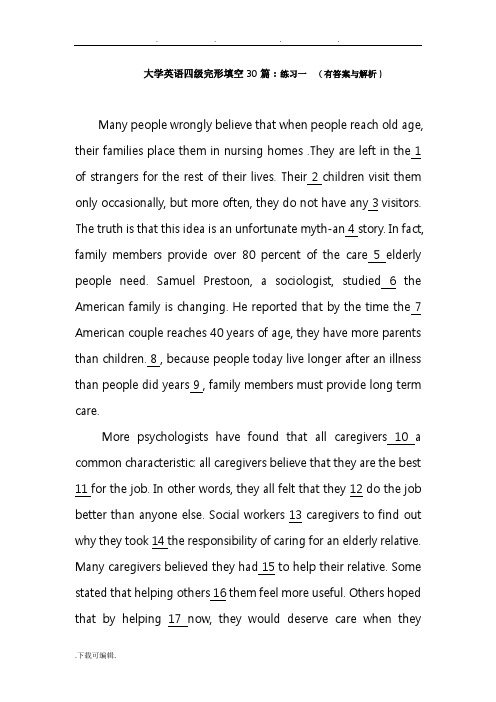
大学英语四级完形填空30篇:练习一(有答案与解析)Many people wrongly believe that when people reach old age, their families place them in nursing homes .They are left in the 1 of strangers for the rest of their lives. Their 2 children visit them only occasionally, but more often, they do not have any 3 visitors. The truth is that this idea is an unfortunate myth-an 4 story. In fact, family members provide over 80 percent of the care 5 elderly people need. Samuel Prestoon, a sociologist, studied 6 the American family is changing. He reported that by the time the 7 American couple reaches 40 years of age, they have more parents than children. 8 , because people today live longer after an illness than people did years 9 , family members must provide long term care.More psychologists have found that all caregivers 10 a common characteristic: all caregivers believe that they are the best 11 for the job. In other words, they all felt that they 12 do the job better than anyone else. Social workers 13 caregivers to find out why they took 14 the responsibility of caring for an elderly relative. Many caregivers believed they had 15 to help their relative. Some stated that helping others 16 them feel more useful. Others hoped that by helping 17 now, they would deserve care when theybecame old and 18 .caring for the elderly and being taken care of can be a 19 satisfying experience for everyone who might be 20 .1. a.hands b.arms c.bodies d.homes2. a.growing b.grown c.being grown d.having grown3. a.constant sting c.regular d.normal4. a.imaginary b.imaginable c.imaginative d.imagery5. a.that b.this c.those d.these6. a.when b.how c.what d.where7. mon b.ordinary c.standard d.average8. a.further b.however c.moreover d.whereas9. a.before b.ago ter tely10. a.share b.enjoy c.divide d.consent11. a.person b.people c.character d.man12. a.would b.will c.could d.can13. a.questioned b.interviewed c.inquired d.interrogate14. a.in b.up c.on d.off15. a.admiration b.initiative c.necessity d.obligation16. a.cause b.enable c.make d.get17. a.someone b.anyone c.everyone d.anybody18. a.elderly b.dependent c.dependabled.independent19. a.similarly b.differently c.mutually d.certainly20. a.involved b.excluded c.included d.considered答案+解析1.【答案】a【解析】本句意为他们的业余生活要由陌生人来照料。
大学英语四级完形填空包括答案解析良心制作

大学英语四级完形填空 ( 附答案分析良知制作 )大学英语四级完形填空第一篇Most people have no idea of the hard work and worry that goes into the Collecting of those fascinating Birds and animals that they pay to see in the zoo.One of the questions that is always asked of me is(1) I Became an animal Collector in the first(2).The answer is that I have always Been interested in animals and zoos. According to my parents, the first word I was able to say with any(3)was not the Conventional“ mamma”or“ daddy”,(4) the word“ zoo ”, which I would(5)over and over again with a shrill(6) until someone, in groups to(7) me up, would take me to the zoo. When I(8) a little older, we lived in Greece and Ihad a great(9) of pets, ranging from owls to seahorses, and I spent all my spare time(10)the Countryside in search of fresh specimens“样品” to(11)to my Collection of pets.(12) on I went for a year to the City Zoo, as a student(13), to get experience of the large animals, such as lions,Bears,Bison and ostriches, (14) were not easy to keep at home. When I left, I(15) had enough money of myown to Be able to(16)my first trip and I have Been going(17)ever since then. Though a Collector's job is not an easy one and is full of(18) , it is Certainly a job which will appeal(19) all those who love animals and(20) .B. whereC. whenD. whetherB. fieldC. placeD.Case清楚 B. emotion C. sentiment (情绪) D. affection (感情)B.But√C. except forD.But forB. recognizeC. readD. repeatB. noiseC. voice √D. pitchB. shut√C. stopfort√ B. was growing C. grow D. grownB. amountC. number √D. supplyB.Cultivating耕作C. reclaiming开垦D. exploring探察B. includeC. add√D. enrich√ B. further C. then D. subsequently佣人 B. keeper C. member D. aideB. theyC. of whichD. which √B. gladlyC. nearlyD. successfullyB. provideC. allowD. finance 支付B. regularlyC. usuallyD. oftenB. sorrowsC. excitementD.Disappointments √B. withC. to √D. fromB. travel√C. journeyD. Trip第一篇分析:1.【答案】 A依据下一句及随后的内容,作者的是怎成物好者的(从小就喜物当 A.how 。
大学英语四级完形填空30篇(附答案)-打印整理版
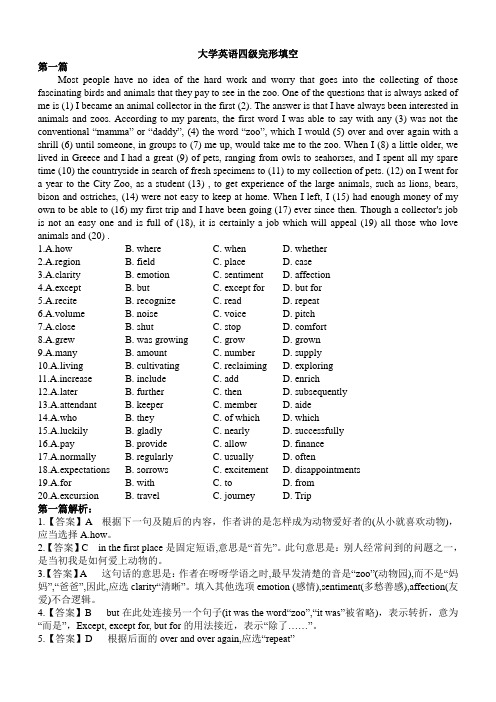
大学英语四级完形填空第一篇Most people have no idea of the hard work and worry that goes into the collecting of those fascinating birds and animals that they pay to see in the zoo. One of the questions that is always asked of me is (1) I became an animal collector in the first (2). The answer is that I have always been interested in animals and zoos. According to my parents, the first word I was able to say with any (3) was not the conventional “mamma” or “daddy”, (4) the word “zoo”, which I would (5) over and over ag ain with a shrill (6) until someone, in groups to (7) me up, would take me to the zoo. When I (8) a little older, we lived in Greece and I had a great (9) of pets, ranging from owls to seahorses, and I spent all my spare time (10) the countryside in search of fresh specimens to (11) to my collection of pets. (12) on I went for a year to the City Zoo, as a student (13) , to get experience of the large animals, such as lions, bears, bison and ostriches, (14) were not easy to keep at home. When I left, I (15) had enough money of my own to be able to (16) my first trip and I have been going (17) ever since then. Though a collector's job is not an easy one and is full of (18), it is certainly a job which will appeal (19) all those who love animals and (20) .1.A.how B. where C. when D. whether2.A.region B. field C. place D. case3.A.clarity B. emotion C. sentiment D. affection4.A.except B. but C. except for D. but for5.A.recite B. recognize C. read D. repeat6.A.volume B. noise C. voice D. pitch7.A.close B. shut C. stop D. comfort8.A.grew B. was growing C. grow D. grown9.A.many B. amount C. number D. supply10.A.living B. cultivating C. reclaiming D. exploring11.A.increase B. include C. add D. enrichter B. further C. then D. subsequently13.A.attendant B. keeper C. member D. aide14.A.who B. they C. of which D. which15.A.luckily B. gladly C. nearly D. successfully16.A.pay B. provide C. allow D. finance17.A.normally B. regularly C. usually D. often18.A.expectations B. sorrows C. excitement D. disappointments19.A.for B. with C. to D. from20.A.excursion B. travel C. journey D. Trip第一篇解析:1.【答案】A 根据下一句及随后的内容,作者讲的是怎样成为动物爱好者的(从小就喜欢动物),应当选择A.how。
四级完形填空练习题附答案解析
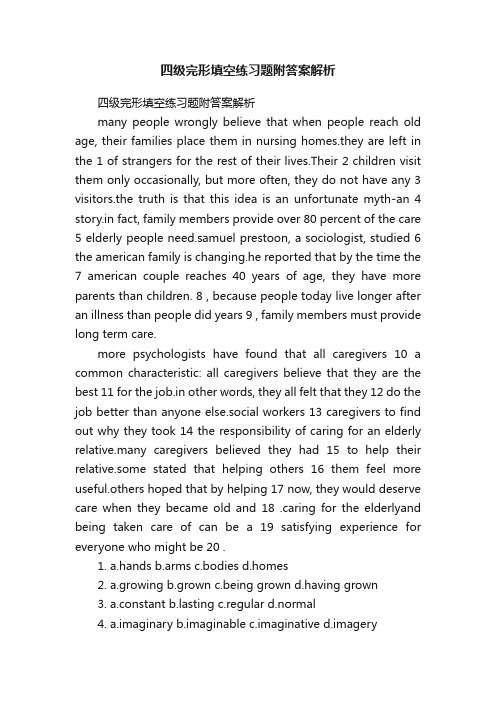
四级完形填空练习题附答案解析四级完形填空练习题附答案解析many people wrongly believe that when people reach old age, their families place them in nursing homes.they are left in the 1 of strangers for the rest of their lives.Their 2 children visit them only occasionally, but more often, they do not have any 3 visitors.the truth is that this idea is an unfortunate myth-an 4 story.in fact, family members provide over 80 percent of the care 5 elderly people need.samuel prestoon, a sociologist, studied 6 the american family is changing.he reported that by the time the 7 american couple reaches 40 years of age, they have more parents than children. 8 , because people today live longer after an illness than people did years 9 , family members must provide long term care.more psychologists have found that all caregivers 10 a common characteristic: all caregivers believe that they are the best 11 for the job.in other words, they all felt that they 12 do the job better than anyone else.social workers 13 caregivers to find out why they took 14 the responsibility of caring for an elderly relative.many caregivers believed they had 15 to help their relative.some stated that helping others 16 them feel more useful.others hoped that by helping 17 now, they would deserve care when they became old and 18 .caring for the elderlyand being taken care of can be a 19 satisfying experience for everyone who might be 20 .1. a.hands b.arms c.bodies d.homes2. a.growing b.grown c.being grown d.having grown3. a.constant sting c.regular d.normal4. a.imaginary b.imaginable c.imaginative d.imagery5. a.that b.this c.those d.these6. a.when b.how c.what d.where7. mon b.ordinary c.standard d.average8. a.further b.however c.moreover d.whereas9. a.before b.ago ter tely10. a.share b.enjoy c.divide d.consent11. a.person b.people c.character d.man12. a.would b.will c.could d.can13. a.questioned b.interviewed c.inquired d.interrogate14. a.in b.up c.on d.off15. a.admiration b.initiative c.necessity d.obligation16. a.cause b.enable c.make d.get17. a.someone b.anyone c.everyone d.anybody18. a.elderly b.dependent c.dependable d.independent19. a.similarly b.differently c.mutually d.certainly20. a.involved b.excluded c.included d.considered答案+解析1.【答案】a【解析】本句意为他们的业余生活要由陌生人来照料。
2023年英语专业四级真题完形填空及答案解析

英语专业四级真题完形填空及答案解析PART III CLOZE[15 MIN]Decide which of the choices given below would best complete the passage if inserted in the corresponding blanks. Mark the best choice for each blank on Answer Sheet Two.How men first learned to invent words is unknown; (31) , the origin of language is a mystery. All we really know is that men, unlike animals, somehow invented certain (32) to express thoughts and feelings, actions and things, (33) they could communicate with each other; and that later they agreed (34) certain signs, called letters, which could be (35) to represent those sounds, and which could be (36) . Those sounds, whether spoken, (37) written in letters, we call words.The power of words, then, lies in their (38) the things they bring up before our minds. Words become (39) with meaning for us by experience; (40) the longer we live, the more certain words (41) to us the happy and sad events of our past; and the more we (42) , the more the number of words that mean something to us (43) .Great writers are those who not only have great thoughts but also express these thoughts in words which appeal (44) to our minds and emotions. This (45) and telling use of words is what we call (46) style. Above all, the real poet is a master of (47) . He can convey his meaning in words which sing like music, and which (48) their position and association can (49) men to tears. We should, therefore, learn to choose our words carefully and use them accurately, or theywill (50) our speech or writing silly and vulgar.31、A. in addition B. in other words C. in a word D. in summary32、A. sounds B. gestures C. signs D. movements33、A. such that B. as that C. so that D. in that34、A. in B. withC. ofD. upon35、A. spelt B. combinedC. writtenD. copied36、A. written down B. handed downC. rememberedD. observed37、A. and B. yetC. alsoD. or38、A. functions B. associationsC. rolesD. links39、A. filled B. fullC. liveD. active40、A. but B. orC. yetD. and41、A. reappear B. recallC. rememberD. recollect42、A. read and think B. read and recallC. read and learnD. read and recite43、A. raises B. increasesC. improvesD. emerges44、A. intensively B. extensivelyC. broadlyD. powerfully45、A. charming B. academicC. conventionalD. common46、A. written B. spokenC. literaryD. dramatic47、A. signs B. wordsC. styleD. sound48、A. in B. onC. overD. by49、A. move B. engageC. makeD. force50、A. transform B. changeC. makeD. convertPART Ⅲ CLOZE答案解析31、B 32、A33、C[解析] 根据句意,人会发出某种特定旳声音来表达对应旳思想感情、行为动作和其他事情,目旳是为了交流,应选C项so that。
英语四级完形填空及答案解析
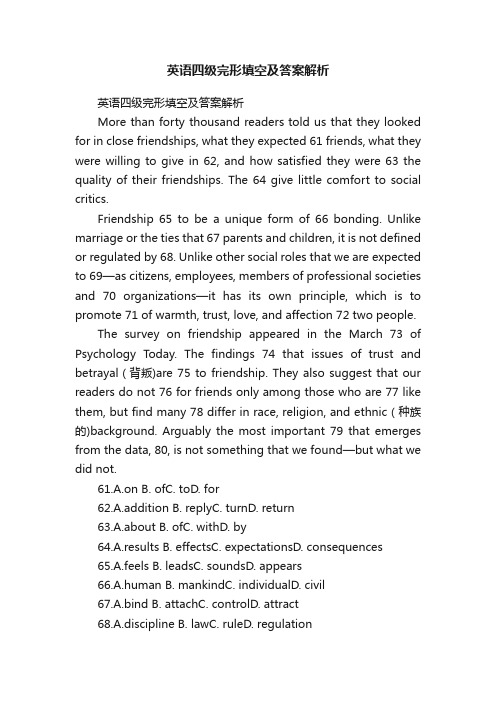
英语四级完形填空及答案解析英语四级完形填空及答案解析More than forty thousand readers told us that they looked for in close friendships, what they expected 61 friends, what they were willing to give in 62, and how satisfied they were 63 the quality of their friendships. The 64 give little comfort to social critics.Friendship 65 to be a unique form of 66 bonding. Unlike marriage or the ties that 67 parents and children, it is not defined or regulated by 68. Unlike other social roles that we are expected to 69—as citizens, employees, members of professional societies and 70 organizations—it has its own principle, which is to promote 71 of warmth, trust, love, and affection 72 two people.The survey on friendship appeared in the March 73 of Psychology Today. The findings 74 that issues of trust and betrayal(背叛)are 75 to friendship. They also suggest that our readers do not 76 for friends only among those who are 77 like them, but find many 78 differ in race, religion, and ethnic(种族的)background. Arguably the most important 79 that emerges from the data, 80, is not something that we found—but what we did not.61.A.on B. ofC. toD. for62.A.addition B. replyC. turnD. return63.A.about B. ofC. withD. by64.A.results B. effectsC. expectationsD. consequences65.A.feels B. leadsC. soundsD. appears66.A.human B. mankindC. individualD. civil67.A.bind B. attachC. controlD. attract68.A.discipline B. lawC. ruleD. regulation69.A.keep B. doC. showD. play70.A.all B. anyC. otherD. those71.A.friendship B. interestsC. feelingsD. impressions72.A.between B. onC. inD. for73.A.print B. issueC. publicationD. copy74.A.secure B. assureC. confirmD. resolve75.A.neutral B. mainC. nuclearD. central76.A.ask B. callC. appealD. look77.A.most B. moreC. leastD. less78.A.people B. whoC. whatD. friends79.A.conclusion B. summaryC. decisionD. claim80.A.moreover B. howeverC. stillD. yet【答案】:61.B62.D63.C64.C65.D66.C67.A68.B69.D70.C71.C72.A73.B74.C75.D76.D77.A78.B79.A80.B【答案解析】:61.B此题考查介词用法。
大学英语四级完形填空(附答案解析良心制作)
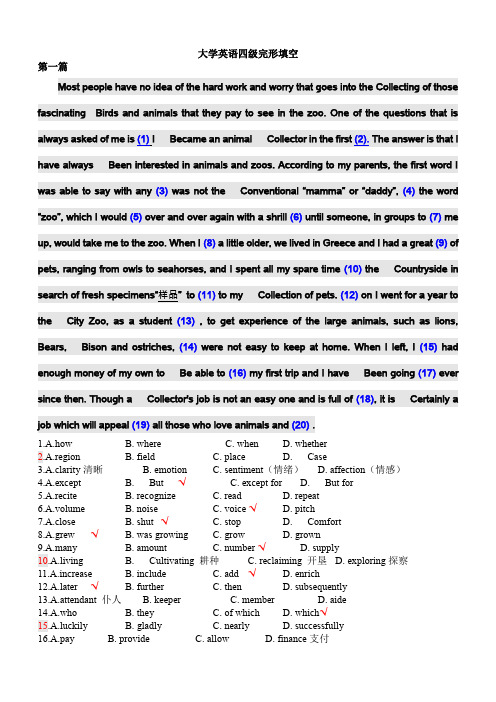
大学英语四级完形填空第一篇Most people have no idea of the hard work and worry that goes into the Collecting of those fascinating Birds and animals that they pay to see in the zoo. One of the questions that ishave always Been interested in animals and zoos. According to my parents, the first word I was able to say with any (3)was not the Conventional “mamma” or “daddy”, (4) the word “zoo”, which I would (5) over and over again with a shrill (6) until someone, in groups to (7) me up, would take me to the zoo. When I (8) a little older, we lived in Greece and I had a great (9) of pets, ranging from owls to seahorses, and I spent all my spare time (10) the Countryside inthe City Zoo, as a student(13) , to get experience of the large animals, such as lions, Bears, Bison and ostriches, (14) were not easy to keep at home. When I left, I (15)had enough money of my own to Be able to (16) my first trip and I have Been going (17) ever since then. Though a Collector's job is not an easy one and is full of (18), it is Certainly a job which will appeal (19) all those who love animals and (20) .1.A.how B. where C. when D. whether2.A.region B. field C. place D. Case3.A.clarity清晰 B. emotion C. sentiment(情绪) D. affection(情感)4.A.except B. But √ C. except for D. But for5.A.recite B. recognize C. read D. repeat6.A.volume B. noise C. voice √ D. pitch7.A.close B. shut √ C. stop D. Comfort8.A.grew √ B. was growing C. grow D. grown9.A.many B. amount C. number √ D. supply10.A.living B. Cultivating 耕种 C. reclaiming 开垦 D. exploring探察11.A.increase B. include C. add √ D. enrichter √ B. further C. then D. subsequently13.A.attendant 仆人 B. keeper C. member D. aide14.A.who B. they C. of which D. which√15.A.luckily B. gladly C. nearly D. successfully16.A.pay B. provide C. allow D. finance支付17.A.normally B. regularly C. usually D. often18.A.expectations B. sorrows C. excitement D. Disappointments√19.A.for B. with C. to√ D. from20.A.excursion B. travel √ C. journey D. Trip第一篇解析:1.【答案】A 根据下一句及随后的内容,作者讲的是怎样成为动物爱好者的(从小就喜欢动物),应当选择A.how。
大学英语四级完形填空(附答案解析良心制作)

第一篇Most people have no idea of the hard work and worry that goes into the Collecti ng ofthose fasc in at ing Birds and ani mals that they pay to see in the zoo. One of the questi ons that is always asked of me is (1) I Became an an imalCollector in the first (2). The an swer isthat I have always Bee n in terested in ani mals and zoos. Accord ing to my pare nts, the first word I was able to say with any (3) was not the Conven ti onal“ mamm ” or “ daddy ”eword “ zoo ” , which I wou(5) over and over aga in with a shrill (6) un til some one, in groups to (7) me up, would take me to the zoo. When I (8) a little older, we lived in Greece and I had a great(9) of pets, ranging from owls to seahorses, and I spent all my spare time (10) the Countryside in search of fresh specimens 样品” to (11) to my Collection of pets. (12) on I went for a year to the City Zoo, as a student (13) , to get experienee of the large animals, such as lio ns,Bears,Bis on and ostriches, (14) were not easy to keep at home. Whe n I left,Be able to (16) my first trip and I have Been going(17) ever since then. Though a Collector's job is not an easy one and is full of (18), it is大学英语四级完形填空1.A.how B. where C. whe n D. whether2.A.region B. fieldC . place D. Case3.A.clarity 清晰B. emoti on C . sen time nt (情绪) D. affection (情感) 4.A.except B. But VC. except forD. But for5.A.recite B. recog nize C . read D. r epeat6.A.volume B. no ise C . voice V D. p itch7.A.closeB. shut VC . stop D. Comfort 8.A.grew V B. was grow ing C. grow D. g row n9.A.ma ny B. amount C . nu mber VD. supply 10.A. livi ng B. Cultivat ing 耕种 C. reclaiming 开垦 D. exploring 探察11.A.i ncrease B. in clude C . add V D. e n rich12. ter V B. further C . the n D. subseque ntly13. A.atte ndant 仆人B. keeperC. memberD. aide 14.A.who B. they C . of which D. which V15.A.luckily B. gladly C . n early D. successfully Certai nly a job which will appeal (19) all those who love an imals and (20).D. finance 支付 C. allow 16.A.payB. provide I (15) had eno ugh money of my own toC. usuallyD. often C. exciteme nt D. Disappoi ntme nts VC. to VD. fromC. journeyD. Trip 1.【答案】A 根据下一句及随后的内容,作者讲的是怎样成为动物爱好者的 (从小就喜欢动物),应当选择A.how 。
大学英语四级完形填空(附答案解析良心制作)

第一篇Most people have no idea of the hard work and worry that goes into the Collecti ng ofthose fasc in at ing Birds and ani mals that they pay to see in the zoo. One of the questi ons thatis always asked of me is (1) I Became an an imal Collector in the first (2). The an swer isthat I have always Bee n in terested in ani mals and zoos. Accord ing to my pare nts, the first word I was able to say with any (3) was not the Conven ti onal “ mamm” or “ daddy ”eword “ zoo” , which I wou(5) over and over aga in with a shrill (6) un til some one, in groups to (7) me up, would take me to the zoo. When I (8) a little older, we lived in Greece and I had a great(9) of pets, ranging from owls to seahorses, and I spent all my spare time (10) the Countryside in search of fresh specimens 样品” to (11) to my Collection of pets. (12) on I went for a year to the City Zoo, as a student (13) , to get experienee of the large animals,such as lio ns, Bears, Bis on and ostriches, (14) were not easy to keep at home. Whe n I left,Be able to (16) my first trip and I have Been going (17) ever since then. Though a Collector's job is not an easy one and is full of (18), it is大学英语四级完形填空1.A.how B. where C. whe n D. whether2.A.region B. field C. place D. Case3.A.clarity 清晰 B. emoti on C. sen timent(情绪) D. affection (情感)4.A.except B. But V C. except for D. But for5.A.recite B. recog nize C. read D. r epeat6.A.volume B. no ise C. voice V D. p itch7.A.close B. shut V C. stop D. Comfort8.A.grew V B. was grow ing C. grow D. g row n9.A.ma ny B. amount C. nu mber V D. supply10.A. livi ng B. Cultivat ing 耕种 C. reclaiming 开垦D. exploring 探察11.A.i ncrease B. in clude C. add V D. e n rich12. ter V B. further C. the n D. subseque ntly13. A.atte ndant 仆人B. keeper C. member D. aide14.A.who B. they C. of which D. which VCertai nly a job which will appeal (19) all those who love an imals and (20).I (15) had eno ugh money of my own toC. usuallyD. often C. exciteme nt D. Disappoi ntme nts V C. to V D. from C. journey D. Trip 1. 【答案】A 根据下一句及随后的内容,作者讲的是怎样成为动物爱好者的 (从小就喜欢动物), 应当选择A.how 。
四级难度英语完形填空一篇带答案解析
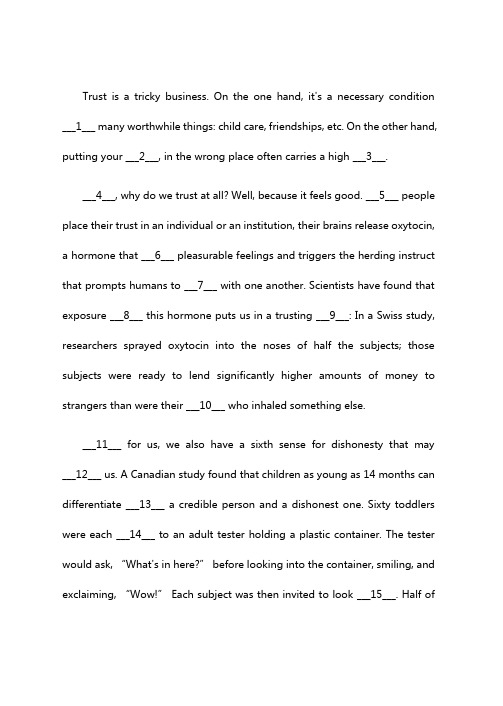
Trust is a tricky business. On the one hand, it's a necessary condition ___1___ many worthwhile things: child care, friendships, etc. On the other hand, putting your ___2___, in the wrong place often carries a high ___3___.___4___, why do we trust at all? Well, because it feels good. ___5___ people place their trust in an individual or an institution, their brains release oxytocin, a hormone that ___6___ pleasurable feelings and triggers the herding instruct that prompts humans to ___7___ with one another. Scientists have found that exposure ___8___ this hormone puts us in a trusting ___9___: In a Swiss study, researchers sprayed oxytocin into the noses of half the subjects; those subjects were ready to lend significantly higher amounts of money to strangers than were their ___10___ who inhaled something else.___11___ for us, we also have a sixth sense for dishonesty that may ___12___ us. A Canadian study found that children as young as 14 months can differentiate ___13___ a credible person and a dishonest one. Sixty toddlers were each ___14___ to an adult tester holding a plastic container. The tester would ask, “What's in here?” before looking into the container, smiling, and exclaiming, “Wow!” Each subject was then invited to look ___15___. Half ofthem found a toy; the other half ___16___the container was empty-and realized the tester had ___17___ them.Among the children who had not been tricked, the majority were ___18___ to cooperate with the tester in learning a new skill, demonstrating that they trusted his leadership. ___19___, only five of the 30 children paired with the "___20___" tester participated in a follow-up activity.1. A. on B. like C. for D. from2. A. faith B. concern C. attention D. interest3. A. benefit B. debt C. hope D. price4. A. Therefore B. Then C. Instead D. Again5. A. Until B. Unless C. Although D. When6. A. selects B. produces C. applies D. maintains7. A. consult B. compete C. connect D. compare8. A. at B. by C. of D. to9. A. context B. mood C. period D. circle10. A. counterparts B. substitutes C. colleagues D. supporters11. A. Funny B. Lucky C. Odd D. Ironic12. A .monitor B. protect C. surprise D. delight13. A. between B. within C. toward D. over14. A. transferred B. added C. introduced D. entrusted15. A. out B. back C. around D. inside16. A. discovered B. proved C. insisted D. remembered17. A. betrayed B. wronged C. fooled D. mocked18. A. forced B. willing C. hesitant D. entitled19. A. In contrast B. As a result C. On the whole D. For instance20. A. inflexible B. incapable C. unreliable D. unsuitable1.【答案】C。
- 1、下载文档前请自行甄别文档内容的完整性,平台不提供额外的编辑、内容补充、找答案等附加服务。
- 2、"仅部分预览"的文档,不可在线预览部分如存在完整性等问题,可反馈申请退款(可完整预览的文档不适用该条件!)。
- 3、如文档侵犯您的权益,请联系客服反馈,我们会尽快为您处理(人工客服工作时间:9:00-18:30)。
英语四级完形填空及解析英语四级完形填空及解析四级完型填空练习(10)A language is a signaling system which operates with symbolic vocal sounds (语声), and which is used by a group of people for the purpose of communication.Let’s look at this 61 in more detail because it is language, more than anything else, 62 distinguishes man from the rest of the 63 world.Other animals, it is true, communicate with one another by 64 of cries: for example, many birds utter 65 calls at the approach of danger; monkeys utter 66 cries, such as expressions of anger, fear and pleasure. 67 these various means of communication differ in important ways 68 human language. For instance, animals’ cries do not 69 thoughts and feelings cle arly. This means, basically, that they lack structure. They lack the kind of structure that 70 us to divide a human utterance into 71.We can change an utterance by 72 one word in it with 73: a good illustration of this is a soldier who can say, e.g., “tan ks approaching from the north”, 74 who can change one word and say “aircraft approaching from the north” or “tanks approaching from the west”; but a bird has a single alarm cry, 75 means “danger!”This is why the number of 76 that an animal can make is very limited: the great tit (山雀) is a case 77 point; it has about twenty different calls, 78 in human language the number of possible utterances is 79. It also explains why animal cries are very 80 in meaning.61.A.classification B. definitionC.functionD.perception62.A.that B. itC.asD.what63.A.native B. humanC. physicalD. animal64.A.ways B. meansC. methodsD. approaches65.A.mating B. excitingC. warningD. boring66.A.identical B. similarC. differentD. unfamiliar67.A.But B.ThereforeC. AfterwardsD. Furthermore68.A.about B. withC. fromD. in69.A.infer B. explainC. interpretD. express70.A. encourages B. enablesC. enforcesD. ensures71.A.speeches B. soundsC. wordsD.voices72.A. replacingB. spellingC. pronouncingD.saying73.A.ours B. theirsC. anotherD. others74.A.so B. andC. butD.or75.A.this B.thatC.whichD.it76.A.signs B.gesturesC.signalsD.marks77.A.in B.atC. ofD.for78.A.whereas B. sinceC. anyhowD.somehow79.A.boundless B. changeableC. limitlessD. ceaseless80.A.ordinary B. alikeC. commonD. general【答案】:61.B 62.C 63.C 64.B 65.C66.C 67.A 68.C 69.D 70.B71.C 72.A 73.C 74.B 75.C76.C 77.A 78.A 79.C 80.B【答案解析】:61.B 此题考查普通词汇。
上文给出的明显是语言的定义,因此,答案选definition。
62.C 此题考查的语法点是定语从句。
从空缺前的逗号可以推断出,这是个非限定性定语从句,四个选项中,能作为非限定性定语从句的关系代词的只有as,表达“正如语言将人类和物质区分开来的一样。
”63.C 此题考查上下文理解。
语言将人和物质世界的其他物质区分开来。
64.B 此处考查固定搭配,by means of表示“通过……方式或途径”。
因此,选B。
65.C 此处考查词汇和上下文理解,在危险来临之际,鸟儿们发出的应该是警告声。
故选warning。
66.C 从后文可得知,猴子能通过声音表达愤怒、恐惧和高兴。
由此推断可知,猴子发出的叫声应该是不同的。
故选C。
67.A 此处考查介词及上下文理解,作者旨在拿动物发出的声音和人类的语言进行比较。
前文叙述动物也能发出不同的声音,这里说的是动物的交流方式与人类语言在几个重大的方面是不同,前后文为转折关系。
故选but。
68.C 此处考查固定搭配:differ from(与……不同)。
69.D infer表示“推断”,explain指“解释”,interpret表示“解释、说明”。
这里选express(表达)最符合文意。
70.B 见71题。
71.C 这两题放在一起来分析。
原文意思应是:“人类拥有能把话语细分成单词的某种结构,而动物却没有。
”70题的encourage(勇敢),enforce(强迫),ensure(保证)都不符合题意。
而71题,比话语更小的单位应该是words。
故此题选C。
72.A 此题考查上下文理解。
下文举例说明的部分提到将一句话的某个词换成另外的词,由此推断可知,此处选择replace(代替)。
73.C 表达用另一个词代替,用another。
74.B 此题考查上下文理解,会说一句话和能够把这句话里的某个单词用别的词替换,这之间表达的应是一种并列关系。
故选B。
75.C 此题考查非限定性定语从句,必须用which。
76.C 动物发出的声音不能形容为“标记”、“记号”或是“手势”,因此,只有signal信号才是正确选择。
77.A 此处考查固定搭配。
in point指“适用的,相关的”78.A 作者将山雀能发出20种叫声与人类语言能发出更多的声音相比较,这里应该选择转折连词:whereas(然而)。
79.C 参照上题,此处将人能发出的声音数量与动物进行比较。
boundless(无界限的),changeable(多变的),ceaseless(不停歇的),因此,正确选项是C。
80.B 根据上文,动物只能发出有限的声音,那它们。
知识点分布情况表考查知识点题号词义辨析66,69,70,72,76,79固定搭配64,68,77语篇理解63,73,80连词67,74,78普通词汇61,65定语从句75小结:从以上这几个表格可以总结,近几年的大学英语四级考试的完型填空部分重点考查词汇,其次是固定搭配,然后是某些常用连词和介词的用法,最后可能涉及某一个语法结构,而定语从句的关系代词又是最常考的。
而这次考查的固定搭配是:by means of(以……的方式),differ from(与……不同)和in point(相关的)。
连词包括:but,and,whereas,其中以表达转折的连词考的居多。
2016年公共英语考试完型填空练习I have always found country life most __1_.The city ,a place _2__ business is only to _3__;it is not an an ideal place for permanent residence.People may say that the city can provide you with the best __4_ life can offer.Your friends are always _5__ for an informal chat or an evening’s entertainment.The _6__ exhinitions,films or plays are always within easy reach.Shopping ,too,is always a pleasure.But what _7__ the hustle and bustle of city like? The city dweller neverhas a moment __8_peace;he is always__9_.And what about the noise and pollution of the city? Day and night the city is in uproar with its unceasing traffic.The air is polluted _10__ prisonous gases emitted by the smokestacks of factories.The water supply is tained with impurities that are harmful to the human body.The city is indeed not a place to live in.Country life is in many respects superior __11_ city life.For one thing , the people there are friendly.People are acquainted with one __12_.You can never _13__ receive a friendly nod or a kind word from anyone you _14__ meet.In the city people who live in the same _15__ are often strangers to one another.The air in the country is fresh and pure.Air pollution is a thing _16__ of there.You live a healthy life in the open air.Life goes on in a _17__ way and you don’t have to hurry to catch _18__ bus or travel in a crowed bus with people _19__ like sardines.Gardening and fishing will be pleasant pasttimes.Reading a book _20__ the warm fireside will be another pleasant pastime on a cold winter night.Life in the country is indeed simple and pleasant.1) A enjoyable B exciting C experienced D unpleasant2) A in B on C out of D for3) A be visiting B be visited C visit D visited4) A where B when C what D who5) A wanted B wanting C available D enjoyable6) A latest B kindest C richest D poorest7) A of B about C if D should8) A for B even C once D often9) A in a moment B at the moment C in a hurry D in a line10) A in B with C of D within11) A than B to C over D for12) A another B other C what else D the others13) A expected to B want to C fail to D plan to14) A long to B be glad to C want to D chance to15) A apartment B school C room D city16) A hearing B unhearing C heard D unheard17) A leisurely B easily C conveniently D effectively18) A a B the C / D no19) A fighting B fighted C packing D packed20) A behind B by C in D onKEYS:adbcc abacb bacda daadb2016年英语四级完型填空试题及答案Many students find the experience of attending universitylectures to be a confusing and frustrating experience.Thelecturer speaks for one or two hours, perhaps 1__ the talk withslides, writing up important information on the blackboard, 2___reading material and giving out 3___ .The new student sees theother students continuously writing on notebooks and 4 ___what to write.Very often the student leaves the lecture 5__notes which do not catch the main points and 6___ becomehard even for the 7___ to understand.Most institutions provide courses which 8 ___new students to develop the skills they need to be9____ listeners and note-takers. 10___ these are unavailable, there are many useful study-skillsguides which 11___ learners to practice these skills 12___ .In all cases it is important to 13___ theproblem 14___ actually starting your studies.It is important to 15___ that most students have difficulty in acquiring the language skills 16__in college study.One way of 17___ these difficulties is to attend the language and study-skillsclasses which most institutions provide throughout the 18__year.Another basic 19__ is to find astudy partner 20__ it is possible to identify difficulties, exchange ideas and provide support.1.A.extending B.illustrating C.performing D.conducting2.A.attributing B.contributing C.distributing D.explaining3.A.assignments rmation C.content D.definition4.A.suspects B.understands C.wonders D.convinces5.A.without B.with C.on D.except6.A.what B.those C.as D.which7.A.teachers B.classmates C.partners D.students8.A.prevent B.require C.assist D.forbid9.A.effective B.passive C.relative D.expressive10.A.Because B.Though C.Whether D.If11.A.enable B.stimulate C.advocate D.prevent12.A.independently B.repeatedly C.logically D.generally13.A.evaluate B.acquaint C.tackle D.formulate 14.A.before B.after C.while D.for15.A.predict B.acknowledge C.argue D.ignore16.A.to require B.required C.requiring D.are required17.A.preventing B.withstanding C.sustaining D.overcoming18.A.average B.ordinary C.normal D.academic19.A.statement B.strategy C.situation D.suggestion20.A.in that B.for which C.with whom D.such as1.【答案】B【解析】将第1,2,3题通盘考虑。
